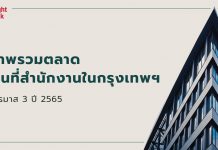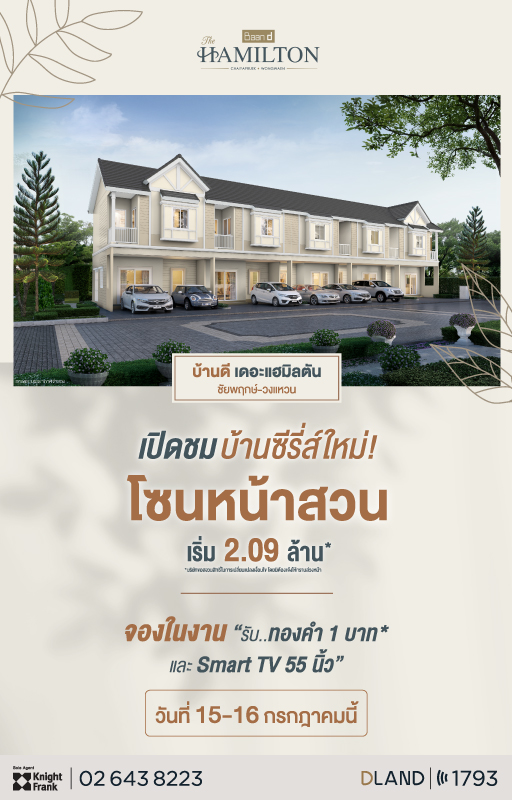Mr. Ek Buranakul, Executive Director and Head of Workplace Strategy, Peoplespace Consulting (Thailand) Co., Ltd., and Knight Frank Thailand Co., Ltd., said that the Covid-19 situation will continue for another year. Meanwhile, the recession may stretch until 2022 before showing signs of recovery. As such, CEOs and senior executives of organizations are seriously shifting the directions of their corporate management. Global organizations experienced a decline in revenue as a result of lockdown announcements in many countries; they also experienced difficulty in remaining competitive, given the restrictions on the number of employees allowed to come to work in the office. At the same time, such organizations had the same level of or additional expenses, which spotlighted the importance of cash flow management considerations, including how to leverage workspaces and workplace facilities.

“The Work+Life during COVID-19 Impact Report” conducted by Peoplespace Consulting (Thailand) Co., Ltd. and Knight Frank Thailand Co., Ltd. found that more than 64% of corporate executives in Thailand believe that organizations must re-examine workspace usage and impart importance to planning workplace strategies in order to analyse and strategize new workspace utilization options; 40% of such executives plan to reduce workspace, 29% are considering ways to enable employees to work closer to home, while only 11% believe that they need to increase the size of the workspace to meet social distancing requirements — all of which result in the below 4 strategies and trends in workspaces during Covid-19.
1. The work area format changes to an activity-based workplace, to reduce the size of and costs incurred by the organization

According to a survey among a vast majority of employees in Thailand, 76% of respondents would like to continue working from home in the future, despite the easing of the Covid-19 situation. Over 41% agree that organizations should have a policy to work from home 1 to 2 days a week, while 24% of employees do not want to work from home at all.
Additionally, 81% of corporate executives in Thailand agree that their current workspace layout is misaligned with the current working style. For this very reason, the organization has an opportunity to modify their workspace to reduce costs and increase employee efficiency. After the Covid-19 situation, organizations expect to reduce their space by over 30 to 50%.

2. Organizational shift towards Digital Workplace (S.M.A.R.T.) increases employee efficiency and productivity
In this context, “SMART” Workplace encompasses: Self-Monitoring, Analysing and Reporting Technology or technology that can independently collect and analyse data and report the results for the Facility Manager (FM) and users to make decisions. This does not only increase efficiency and enhance the work experience, but also makes the organization manage the workspace more effectively and reduce costs in the future.
3. Exposure in the workplace (Contactless Journey) is minimized, to help build confidence among employees and create good hygiene in the organization
Survey results show that we are often exposed to various surfaces in the work areas more than 200 times a day; this includes contact with doors, knobs, elevator buttons, chairs, meeting tables, remote controls, faucets, toilets, trash cans, parking cards, etc. That’s 200 surfaces with potential risk of exposure to Covid-19. Contactless journey design can certainly lower such exposure at work, which thereby reduces the risk of outbreaks (building resource management, cleaning and controls will become more effective in the process as well).
4. Well-working and collaborative climate in the workplace becomes key to attracting employees, going beyond the aesthetics of the space
The organization must turn their attention to workplace hygiene and encouraging a more collaborative workplace spirit, as this creates a work experience that meets the needs of employees. Also, the organization should take this opportunity to adjust the working area. Investing in aesthetically-pleasing workspaces may not be the top priority for employees anymore, but modifications to the office furniture to suit both activities and work may be something worth considering.
In order to create a workplace strategy for organizing work areas to meet business needs, the relationship between ‘people’ and ‘space’ must be forged in such a way that maximizes efficiency and reduces costs to justify the organization’s investment in new workspaces. In the long term, there is a need to create value (ROI) and save on costs, support greater staff productivity, attain employee satisfaction, retain and attract a workforce calibre, and enhance brand value.

Workplace strategy is not only about the design of the space to please the eye; rather, it reflects design for performance. As such, it is categorized as Facility Management (FM) and Corporate Real Estate (CRE) work, which is primarily focused on managing the balance between enhancing the quality of life of building occupants and increasing productivity to support the core business.
The organization should take advantage of the Covid-19 situation to maximize the benefits through adjusting the working space to save the most expenses, and shifting work styles to better suit the work conditions to increase efficiency, attract employees and build confidence among the staff – all as a means of creating a sustainable business in the future.














